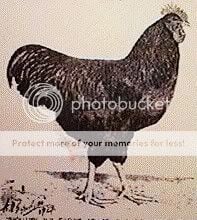- Jan 14, 2008
- 5,644
- 488
- 303
As I see the point Mr Hagan is making it's that the "Production Red" people selected for a set of traits, The "Show type Red" people selected for a different set of traits resulting in different appearances but both strains remained Rhode Island Reds.
As far as the New Hampshires are concerned breeders selected for yet another sewt of traits with the goal in mind of developing another breed.
I suppose the "Prodection Red" breeders might also have chosen to give the strain they selected for a different breed name as well but they didn't.
I have a fairly extensive collection of old poultry magazinesdating back as far as the late 1800s. They contain breeder ads for Rhode Island Reds that laid over 300 eggs per year but these birds weren't anything that you or I might want to reproduce for show as they bore little resemblence to "Show Type Reds". That's how old this controversy is though.
I guess for me it's kind of a so what issue.To someone says they have Rhode Island Reds & they're obviously production bred birds I can say nice! I bet they lay a lot of eggs. I they say they want to show them I explain why they won't do well in the show because that's not what they were bred for.
There are a lot of reasoms to have chickens. Some I get, some I don't. I don't understand why someone would want to keep a diapered chicken in their hous. I do understand why someone would want to develop a strain of chickens that lay a lot of eggs.
As far as the New Hampshires are concerned breeders selected for yet another sewt of traits with the goal in mind of developing another breed.
I suppose the "Prodection Red" breeders might also have chosen to give the strain
I have a fairly extensive collection of old poultry magazinesdating back as far as the late 1800s. They contain breeder ads for Rhode Island Reds that laid over 300 eggs per year but these birds weren't anything that you or I might want to reproduce for show as they bore little resemblence to "Show Type Reds". That's how old this controversy is though.
I guess for me it's kind of a so what issue.To someone says they have Rhode Island Reds & they're obviously production bred birds I can say nice! I bet they lay a lot of eggs. I they say they want to show them I explain why they won't do well in the show because that's not what they were bred for.
There are a lot of reasoms to have chickens. Some I get, some I don't. I don't understand why someone would want to keep a diapered chicken in their hous. I do understand why someone would want to develop a strain of chickens that lay a lot of eggs.









